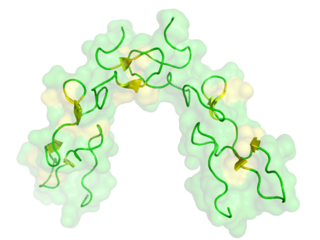Matrix metalloproteinases (MMPs), also known as matrix metallopeptidases or matrixins, are metalloproteinases that are calcium-dependent zinc-containing endopeptidases; other family members are adamalysins, serralysins, and astacins. The MMPs belong to a larger family of proteases known as the metzincin superfamily.

Disintegrins are a family of small proteins from viper venoms that function as potent inhibitors of both platelet aggregation and integrin-dependent cell adhesion.

Convulxin is a snake venom toxin found in a tropical rattlesnake known as Crotalus durissus terrificus. It belongs to the family of hemotoxins, which destroy red blood cells or, as is the case with convulxin, induce blood coagulation.

The western diamondback rattlesnake or Texas diamond-back is a rattlesnake species and member of the viper family, found in the southwestern United States and Mexico. Like all other rattlesnakes and all other vipers, it is venomous. It is likely responsible for the majority of snakebite fatalities in northern Mexico and the greatest number of snakebites in the U.S. No subspecies are currently recognized.

ADAMs are a family of single-pass transmembrane and secreted metalloendopeptidases. All ADAMs are characterized by a particular domain organization featuring a pro-domain, a metalloprotease, a disintegrin, a cysteine-rich, an epidermal-growth factor like and a transmembrane domain, as well as a C-terminal cytoplasmic tail. Nonetheless, not all human ADAMs have a functional protease domain, which indicates that their biological function mainly depends on protein–protein interactions. Those ADAMs which are active proteases are classified as sheddases because they cut off or shed extracellular portions of transmembrane proteins. For example, ADAM10 can cut off part of the HER2 receptor, thereby activating it. ADAM genes are found in animals, choanoflagellates, fungi and some groups of green algae. Most green algae and all land plants likely lost ADAM proteins.

Platelet glycoprotein VI (GPVI) is a glycoprotein receptor for collagen which is expressed in platelets. In humans, glycoprotein VI is encoded by the GP6 gene. It was first cloned in 2000 by several groups including that of Martine Jandrot-Perrus from INSERM.

Matrilysin also known as matrix metalloproteinase-7 (MMP-7), pump-1 protease (PUMP-1), or uterine metalloproteinase is an enzyme in humans that is encoded by the MMP7 gene. The enzyme has also been known as matrin, putative metalloproteinase-1, matrix metalloproteinase pump 1, PUMP-1 proteinase, PUMP, metalloproteinase pump-1, putative metalloproteinase, MMP). Human MMP-7 has a molecular weight around 30 kDa.

A disintegrin and metalloproteinase with thrombospondin motifs 4 is an enzyme that in humans is encoded by the ADAMTS4 gene.

Disintegrin and metalloproteinase domain-containing protein 12 is an enzyme that in humans is encoded by the ADAM12 gene. ADAM12 has two splice variants: ADAM12-L, the long form, has a transmembrane region and ADAM12-S, a shorter variant, is soluble and lacks the transmembrane and cytoplasmic domains.
Platelet membrane glycoproteins are surface glycoproteins found on platelets (thrombocytes) which play a key role in hemostasis. When the blood vessel wall is damaged, platelet membrane glycoproteins interact with the extracellular matrix.

A Disintegrin and metalloproteinase domain-containing protein 10, also known as ADAM10 or CDw156 or CD156c is a protein that in humans is encoded by the ADAM10 gene.

Disintegrin and metalloproteinase domain-containing protein 22, also known as ADAM22, is an enzyme that in humans is encoded by the ADAM22 gene.

Disintegrin and metalloproteinase domain-containing protein 23 is a non-catalytic protein that in humans is encoded by the ADAM23 gene. It is a member of the ADAM family of extracellular matrix metalloproteinases.

Disintegrin and metalloproteinase domain-containing protein 28 is an enzyme that in humans is encoded by the ADAM28 gene.
Angiogenesis is the process of forming new blood vessels from existing blood vessels, formed in vasculogenesis. It is a highly complex process involving extensive interplay between cells, soluble factors, and the extracellular matrix (ECM). Angiogenesis is critical during normal physiological development, but it also occurs in adults during inflammation, wound healing, ischemia, and in pathological conditions such as rheumatoid arthritis, hemangioma, and tumor growth. Proteolysis has been indicated as one of the first and most sustained activities involved in the formation of new blood vessels. Numerous proteases including matrix metalloproteinases (MMPs), a disintegrin and metalloproteinase domain (ADAM), a disintegrin and metalloproteinase domain with throbospondin motifs (ADAMTS), and cysteine and serine proteases are involved in angiogenesis. This article focuses on the important and diverse roles that these proteases play in the regulation of angiogenesis.
Hementerin is a metalloprotease found in the saliva of a hematophagous leech, Haementeria depressa, which is responsible for the anticoagulant property of the animal's bite to prolong blood sucking from the host. It was discovered in 1955 at the Butantan Institute, in São Paulo, Brazil, by Gastão Rosenfeld and collaborators.
Atrolysin B is an enzyme. This enzyme catalyses the following chemical reaction
Atrolysin C is an enzyme. This enzyme catalyses the following chemical reaction
Atrolysin E is an enzyme. This enzyme catalyses the following chemical reaction

Disintegrin and metalloproteinase domain-containing protein 20 is an enzyme that in humans is encoded by the ADAM20 gene. It is a membrane disintegrin-metalloprotease that belongs to the ADAM family. It is exclusively expressed in Testes and is similar to sperm cell-specific fertilins -alpha and -beta.













